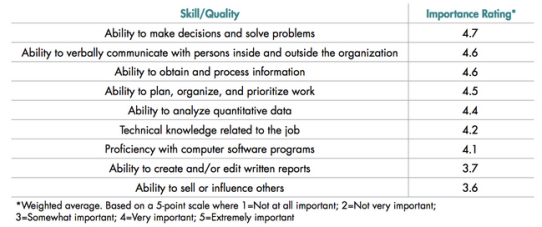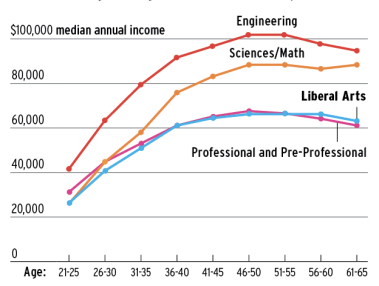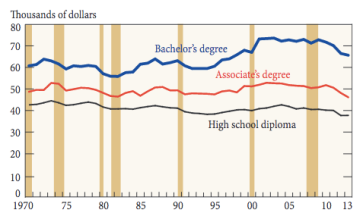– Jeanne M. Slattery and Melissa K. Downes
Melissa often has her composition students write their final papers on issues related to higher education. Many of her students choose the topic “Is College Worth It?” and many of those students (despite assigned readings and in-class discussion) focus predominantly, even exclusively, on the economic benefits or/and costs of college. Last semester, about two-thirds concluded that college is worth it, despite student debt; the other third argued, in the face of fairly convincing evidence, that it is not.
Melissa’s students are not alone. We live in a world full of people trying to reduce education to a simple equation. Consider Bill Gates (but see Times Editorial Board, 2016). As we consider the narrative that is being spun about education, we see at least ten myths. We think these myths are pernicious and damaging – to universities, students, our communities, and our nation’s attitudes about learning and education.
We considered four myths in the previous piece in this series and discuss six more myths here.
Myth 5: The liberal arts are useless in the “real world.”
There are some things that students and parents clearly recognize as leading to success in the real world. Generally these things are practical, with significant face validity predictive of success (e.g., learning how to give an injection or learning how to use open and closed questions effectively). One of the difficulties inherent in discussions of college educations is that much that faculty want students to learn has less face validity. Many do not see the value of the skills taught, nor see the relationship between class assignments and these goals. We faculty have much to do to help our students recognize these connections.
Kalt (2016), for example, argues that “a well-rounded liberal arts degree establishes a foundation of critical thinking. Critical thinkers can accomplish anything…. A critical thinker is a self-learning machine that is not constrained by memorizing commands or syntax” (para. 4). These critical thinking skills are invaluable in a range of situations: on the job, of course, but also while buying a house, choosing a mortgage, or going to the voting box. Or, as Lagemann and Lewis (2012) argue,
Educated citizens must be able to listen intently and empathetically to other people; to analyze rationally what is said, read, and observed; to present thoughts clearly and to debate their merits vigorously; to confront unsupported assertions head on, rather than to dismiss or ignore them, or to talk past them with equally unfounded assertions; and, when appropriate, to identify reasonable strategies to take necessary action. (p. 29)
In fact, in a study by the National Association of Colleges and Employers (Adams, 2014), employers of 161 companies in industries ranging from agriculture to energy to retail were surveyed. They ranked a variety of nontechnical skills including problem solving, oral communication, information literacy, and quantitative reasoning higher than technical skills in their field. See Table 1. Of course, having technical skills in the field was also ranked as Very Important.
The liberal arts have an essential place in the world.

Table 1. Data reported by National Association of Colleges and Employers (2014), from a survey of 161 employers.
Myth 6: Skills learned apply only to the field studied.
A strong college education builds a range of skills that are transferrable to a range of settings and positions. Birge (2016) concluded that a liberal arts education builds “strong writing skills, the abilities to read critically and compare and contrast information, to identify and resolve problems, and to work independently and in collaboration with others” (para. 14). Slattery and Forden (2014) conclude that an education in psychology builds these skills, but also research skills, quantitative reasoning, empathy, understanding the role of context, and more.
When Jeanne writes letters of recommendation for students entering other fields, she stresses these skills. As a result, her department has had students successfully go on in business, law, medicine, criminal justice, clinical psychology, and more. One of the things that we need to teach our graduates to do is recognize these skills and communicate them effectively to employers.
Myth 7: Alumni salaries are the best indicators of program success.
Abel and Deitz (2014) conclude that some degrees have higher investment returns (in earning power) than others. The average annual return rate of a college degree is 15% across majors, with engineering at 21%, and leisure and hospitality at 11%. Most majors, though, cluster around the mean: Technologies (15%), Social Sciences (15%), Science (14%), and Architecture (14%).
But who said that success could be identified solely – or even at all – from the size of one’s paycheck? See Myth 10.
Myth 8: Liberal arts students will never get a job. Certain majors will guarantee success following graduation.

Figure 1. Data reported by National Association of Colleges and Employers (2014), from a survey of 161 employers.
A recent study by the Association of American Colleges and Universities (Martindale, 2014) concluded that liberal arts majors earn on average less than science, engineering, and mathematics majors, but earn about the same as those in professional and preprofessional fields like business. See Figure 1.
We are suspicious of absolutes like “never” and “guarantee.” The numbers Abel and Deitz (2014) report about earning power are averages, probably with significant variability. What differentiates one person’s earning power from another in the same field? We suspect that these differences are due to a range of other things: skills and experiences developed during college, networking skills, willingness to change positions, and even luck.
Certainly we can empathize with parents and students who hope that their investment in college will pay off financially. Like Birge (2016), however, we are troubled “that parents and students often don’t understand it is not the degree that gets the job offer, but the education that positions the student to be the most competitive in the labor market” (para. 11, italics added).
Myth 9: A college degree is no longer a good investment.

Figure 2. Average annual wages, by educational attainment, 1970-2013. Data drawn from US Census Bureau and US Bureau of Labor Statistics, Current Population Survey, March Supplement; US Bureau of Labor Statistics, consumer price index.
Abel and Deitz (2014), in their comparisons of earning power of college graduates with people earning lesser amounts of education, concluded that college graduates earn 56% more than those only graduating from high school. See Figure 2. This comparison is only between people working full-time. The difference would be greater if we were considering the whole of each group, as more high school graduates are unemployed or working only part-time.
Vandenbroucke (2015) approached this question using a different methodology, studying cohorts of white men across their lifespan – to avoid confounds associated with discrimination that would be found in a more diverse group. College-educated white men from the 1980 cohort, the most recent one reported, are expected to earn 52% more over their lifetime than men with only a high school education. This college advantage has been getting larger across time, from a 37% advantage with the 1940s cohort.
Even with the greater costs of a college education, Abel and Dietz (2014) conclude that a bachelor’s degree is “worth it” economically, as a college education, on average, has a 15% annual return rate – well above what one might expect from stocks (7%) or bonds (3%). Remember, though, that we reject that the only benefit from college worth considering is earning power.
Myth 10: The only reason to go to college is to get a job; the benefits of college are mostly economic.
When Jeanne was a child, her grandmother often sang, “I want to go to college, to gain a lot of knowledge.” Her grandmother’s generation didn’t really think about the economic benefits of college (nor did her own); we were convinced that there were enough other benefits from college – we’d simply be better people. See Myth #5.
While there are clear economic benefits to attending college, as we will discuss in response to later myths, the benefits seem to extend to quality of life: people who attend college tend to be happier on average than people with lower levels of educational attainment (Freakonomics, 2008). See Figure 3. Happiness is related to income at lower levels of the continuum – probably because people with lower incomes have more stressors. Income probably doesn’t explain the whole difference in happiness between people with college educations and those without, however, as income-related happiness tends to stabilize after about $50-75k. People with higher levels of education also tend to have more responsibility, autonomy on the job, and opportunities for engagement, which tend to be related to greater perceptions of meaning and purpose. All of these factors reliably predict happiness.
Of course, it is not just any college education that has these positive effects. Alumni who had positive mentoring relationships with their faculty, who were actively involved in their university, and took coursework that was highly engaging were more likely to report that they were thriving after college and to perceive that college had been worth it (Gallup-Purdue Index, 2015). We found similar patterns with our undergraduate psychology majors (Slattery & Potter, 2015).
There are many ways that our culture spreads distortions, half-truths, and out and out lies about educations. These distortions are ways of justifying cutting educational programs and funding. They serve to dismiss science, its findings (e.g., climate change, immunology, and evolution), and recommendations (e.g., about making environmental change and administering vaccines).
Are there myths that you think we missed? Leave your suggestions in the Comments. Thanks to Karen Bingham, Sean Boileau, Danielle Bryan, Iseli Krauss, Miguel Olivas-Lujan, Crystal Park, Kelly Sells, who generously shared their concerns about contemporary views of higher education.
References
Abel, J. R., & Deitz, R. (2014). Do the benefits of college still outweigh the costs? Current Issues in Economics and Finance, 20, 1-9. Retrieved from https://www.newyorkfed.org/medialibrary/media/research/current_issues/ci20-3.pdf
Adams, S. (2014). The college degrees and skills employers most want. Forbes. Retrieved from http://www.forbes.com/sites/susanadams/2014/04/16/the-college-degrees-and-skills-employers-most-want/#575dfd843fd2
Birge, J. F. (2016). James F. Birge: A liberal arts education for the 21st century. Berkshire Eagle. Retrieved from http://www.berkshireeagle.com/columnists/ci_29961305/james-f-birge-liberal-arts-education-21st-century
Freakonomics. (2008). Happiness inequality #2: Differences between groups. Retrieved from http://freakonomics.com/2008/08/05/happiness-inequality-2-differences-between-groups/
Gallup-Purdue Index. (2015). Great jobs, great lives. Retrieved from http://www.gallup.com/services/185924/gallup-purdue-index-2015-report.aspx
Kalt, D. (2016). Why I was wrong about liberal-arts majors. Wall Street Journal. Retrieved from http://blogs.wsj.com/experts/2016/06/01/why-i-was-wrong-about-liberal-arts-majors/
Lagemann, E. C., & Lewis, H. (2012). Renewing the civic mission of American higher education. In E. C. Lagemann and H. Lewis (Eds.), What is college for? The public purpose of higher education (pp. 9-44). New York, NY: Teachers College Press.
Martindale, S. (2014). Liberal-arts majors find good-paying jobs, salaries study finds. Orange County Register. Retrieved from http://www.ocregister.com/articles/arts-598357-liberal-science.html
Slattery, J. M., & Forden, C. (2014, Fall). What psychology students learn: Ten skills that any employer will appreciate. Eye on Psi Chi, 19, 14-17.
Slattery, J. M., & Potter, R. M. (2015, June). Big Six: Roles of support and experiences in perceived preparation for life. Poster presented at the annual convention of the Pennsylvania Psychological Association, Harrisburg, PA.
Times Editorial Board. (2016). Gates Foundation failures show philanthropists shouldn’t be setting America’s public school agenda. LA Times. Retrieved from http://www.latimes.com/opinion/editorials/la-ed-gates-education-20160601-snap-story.html
Vandenbroucke, G. (2015). Lifetime benefits of an education have never been so high. Federal Reserve Bank of St. Louis. Retrieved from https://www.stlouisfed.org/publications/regional-economist/july-2015/lifetime-benefits-of-an-education-have-never-been-so-high#endnotes
Jeanne M. Slattery is a professor of psychology at Clarion University. She sees herself as a learner-centered teacher and loves thinking about what makes teaching and learning successful. She has written three books: Trauma, meaning, and spirituality: Research and clinical perspectives; Counseling diverse clients: Bringing context into therapy; and Empathic counseling: Meaning, context, ethics, and skill. She can be contacted at jslattery@clarion.edu
Melissa K. Downes is an associate professor of English at Clarion University. She loves teaching. She is interested in talking about how people teach and enjoys sharing how she teaches. She is an 18th century specialist, an Anglophile, a cat lover, and a poet. She can be contacted at mdownes@clarion.edu



A few years ago, Greg Goodman (Emeritus Professor of Education from Clarion) and I analyzed a database of current students. I was surprised to see a strong and statistically significant correlation between the students’ GPA and their parents’ education and told Greg about it. He told me that it is a VERY well-known effect in Education research. For me, that is very strong evidence that higher education impacts not only our current students but their children as well!! And I believe there are also studies showing less criminality, more marital stability, longer life, and many other benefits of education. Whoever says “but not everybody needs a university education” is condemning a portion of our population to a higher chance of unemployment, lower income, and many other undesirable outcomes…
LikeLiked by 1 person
I agree! Sounds like a good HiH for you to write!
LikeLike